University Business Law Assignment 1: Contract Law Analysis and Issues
VerifiedAdded on 2020/05/28
|8
|1500
|39
Homework Assignment
AI Summary
This document presents a comprehensive solution to a Business Law assignment focusing on contract law principles. The assignment addresses two key problems: the formation of a contract between a customer and a café, and the café's ability to avoid liability based on exclusion clauses printed on a ticket. The solution analyzes the issues, relevant rules, and applications, drawing on case law such as Chappleton v Barry UDCC and the Australian Consumer Law. The second part of the assignment delves into the different types of contract terms, including express terms, pre-contractual statements, displayed terms, and implied terms, providing definitions and examples. References to relevant legal cases and materials are also provided to support the analysis. The assignment offers a detailed understanding of contract law concepts and their practical application.
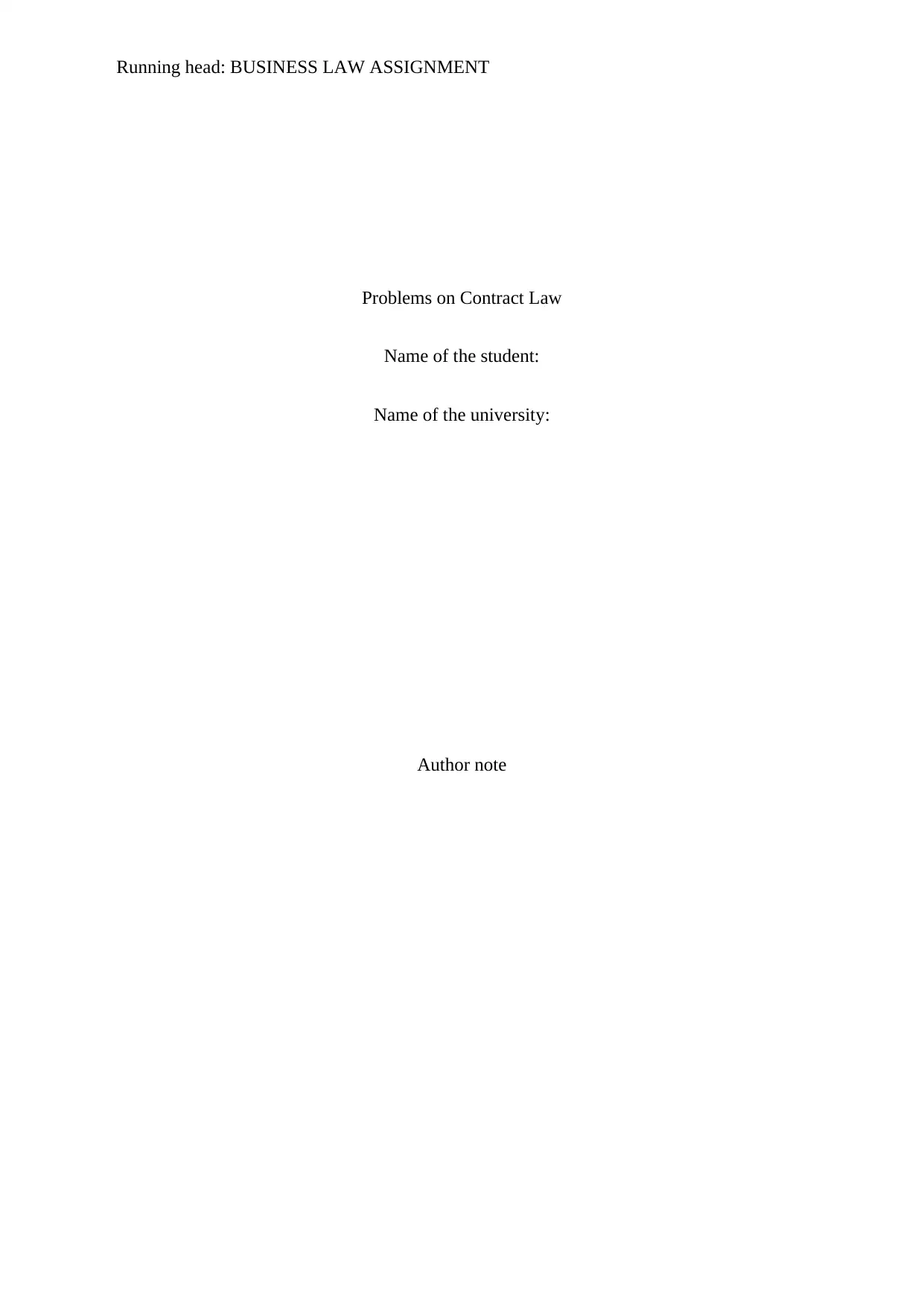
Running head: BUSINESS LAW ASSIGNMENT
Problems on Contract Law
Name of the student:
Name of the university:
Author note
Problems on Contract Law
Name of the student:
Name of the university:
Author note
Paraphrase This Document
Need a fresh take? Get an instant paraphrase of this document with our AI Paraphraser
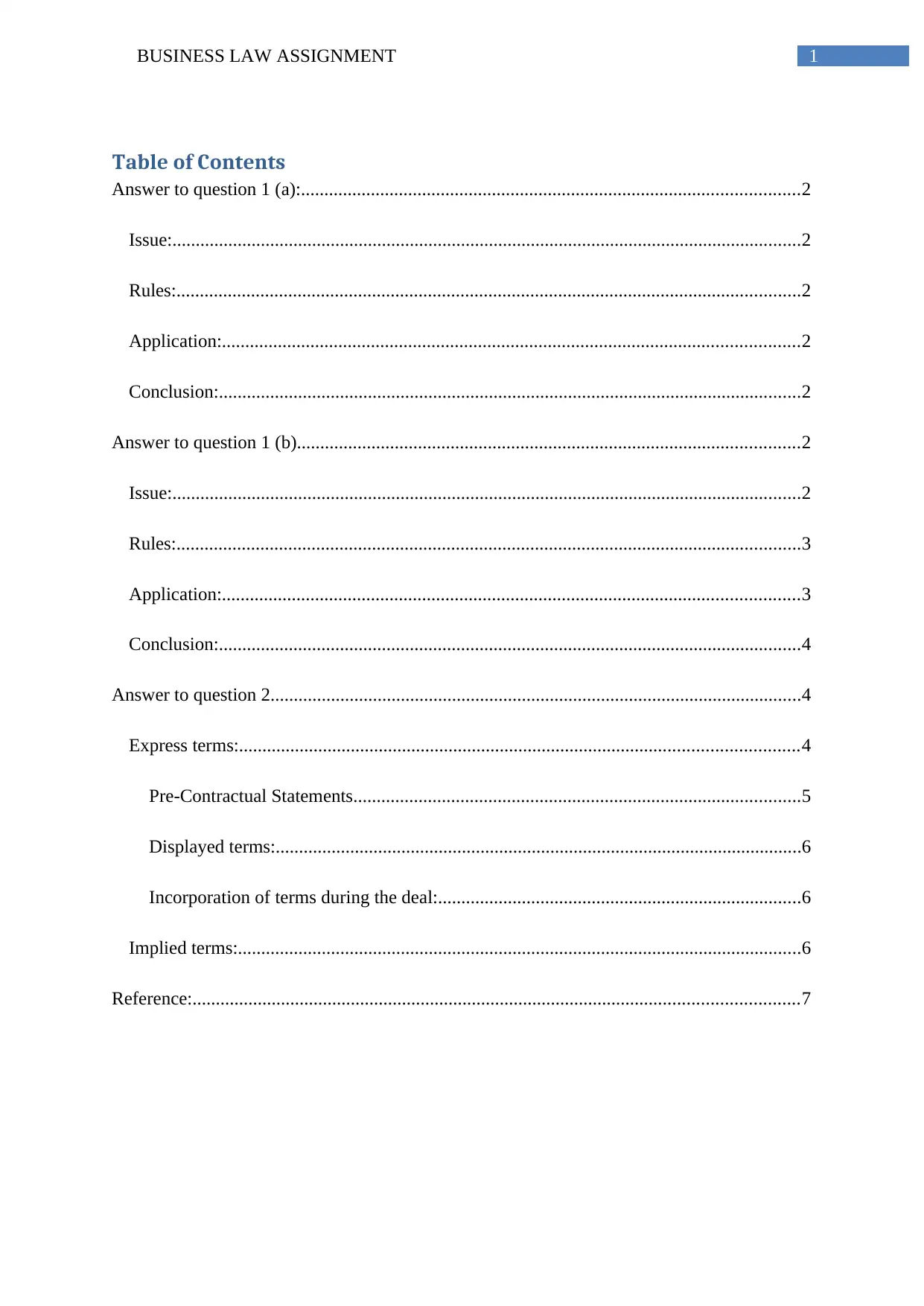
1BUSINESS LAW ASSIGNMENT
Table of Contents
Answer to question 1 (a):...........................................................................................................2
Issue:.......................................................................................................................................2
Rules:......................................................................................................................................2
Application:............................................................................................................................2
Conclusion:.............................................................................................................................2
Answer to question 1 (b)............................................................................................................2
Issue:.......................................................................................................................................2
Rules:......................................................................................................................................3
Application:............................................................................................................................3
Conclusion:.............................................................................................................................4
Answer to question 2..................................................................................................................4
Express terms:........................................................................................................................4
Pre-Contractual Statements................................................................................................5
Displayed terms:.................................................................................................................6
Incorporation of terms during the deal:..............................................................................6
Implied terms:.........................................................................................................................6
Reference:..................................................................................................................................7
Table of Contents
Answer to question 1 (a):...........................................................................................................2
Issue:.......................................................................................................................................2
Rules:......................................................................................................................................2
Application:............................................................................................................................2
Conclusion:.............................................................................................................................2
Answer to question 1 (b)............................................................................................................2
Issue:.......................................................................................................................................2
Rules:......................................................................................................................................3
Application:............................................................................................................................3
Conclusion:.............................................................................................................................4
Answer to question 2..................................................................................................................4
Express terms:........................................................................................................................4
Pre-Contractual Statements................................................................................................5
Displayed terms:.................................................................................................................6
Incorporation of terms during the deal:..............................................................................6
Implied terms:.........................................................................................................................6
Reference:..................................................................................................................................7
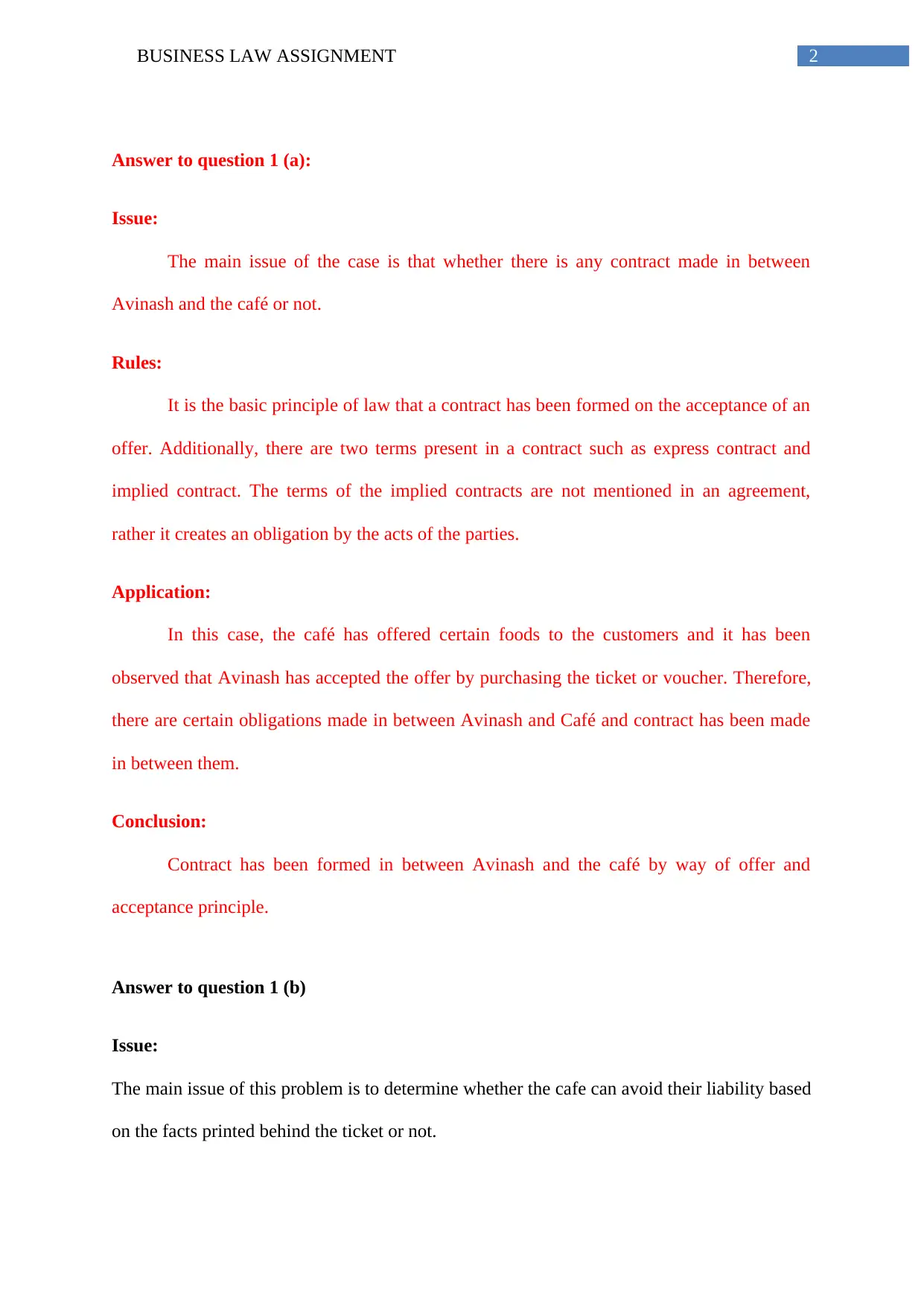
2BUSINESS LAW ASSIGNMENT
Answer to question 1 (a):
Issue:
The main issue of the case is that whether there is any contract made in between
Avinash and the café or not.
Rules:
It is the basic principle of law that a contract has been formed on the acceptance of an
offer. Additionally, there are two terms present in a contract such as express contract and
implied contract. The terms of the implied contracts are not mentioned in an agreement,
rather it creates an obligation by the acts of the parties.
Application:
In this case, the café has offered certain foods to the customers and it has been
observed that Avinash has accepted the offer by purchasing the ticket or voucher. Therefore,
there are certain obligations made in between Avinash and Café and contract has been made
in between them.
Conclusion:
Contract has been formed in between Avinash and the café by way of offer and
acceptance principle.
Answer to question 1 (b)
Issue:
The main issue of this problem is to determine whether the cafe can avoid their liability based
on the facts printed behind the ticket or not.
Answer to question 1 (a):
Issue:
The main issue of the case is that whether there is any contract made in between
Avinash and the café or not.
Rules:
It is the basic principle of law that a contract has been formed on the acceptance of an
offer. Additionally, there are two terms present in a contract such as express contract and
implied contract. The terms of the implied contracts are not mentioned in an agreement,
rather it creates an obligation by the acts of the parties.
Application:
In this case, the café has offered certain foods to the customers and it has been
observed that Avinash has accepted the offer by purchasing the ticket or voucher. Therefore,
there are certain obligations made in between Avinash and Café and contract has been made
in between them.
Conclusion:
Contract has been formed in between Avinash and the café by way of offer and
acceptance principle.
Answer to question 1 (b)
Issue:
The main issue of this problem is to determine whether the cafe can avoid their liability based
on the facts printed behind the ticket or not.
⊘ This is a preview!⊘
Do you want full access?
Subscribe today to unlock all pages.

Trusted by 1+ million students worldwide
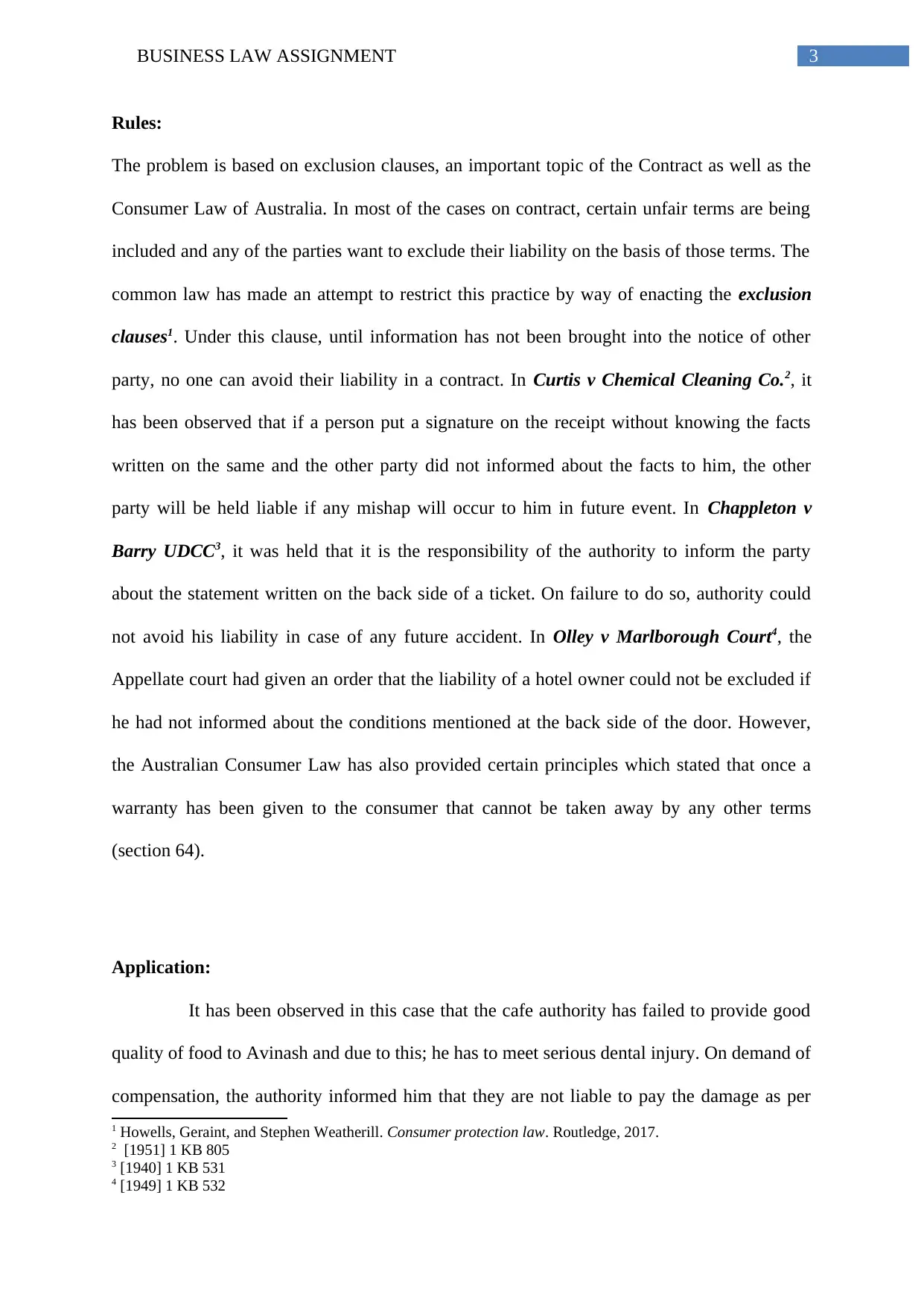
3BUSINESS LAW ASSIGNMENT
Rules:
The problem is based on exclusion clauses, an important topic of the Contract as well as the
Consumer Law of Australia. In most of the cases on contract, certain unfair terms are being
included and any of the parties want to exclude their liability on the basis of those terms. The
common law has made an attempt to restrict this practice by way of enacting the exclusion
clauses1. Under this clause, until information has not been brought into the notice of other
party, no one can avoid their liability in a contract. In Curtis v Chemical Cleaning Co.2, it
has been observed that if a person put a signature on the receipt without knowing the facts
written on the same and the other party did not informed about the facts to him, the other
party will be held liable if any mishap will occur to him in future event. In Chappleton v
Barry UDCC3, it was held that it is the responsibility of the authority to inform the party
about the statement written on the back side of a ticket. On failure to do so, authority could
not avoid his liability in case of any future accident. In Olley v Marlborough Court4, the
Appellate court had given an order that the liability of a hotel owner could not be excluded if
he had not informed about the conditions mentioned at the back side of the door. However,
the Australian Consumer Law has also provided certain principles which stated that once a
warranty has been given to the consumer that cannot be taken away by any other terms
(section 64).
Application:
It has been observed in this case that the cafe authority has failed to provide good
quality of food to Avinash and due to this; he has to meet serious dental injury. On demand of
compensation, the authority informed him that they are not liable to pay the damage as per
1 Howells, Geraint, and Stephen Weatherill. Consumer protection law. Routledge, 2017.
2 [1951] 1 KB 805
3 [1940] 1 KB 531
4 [1949] 1 KB 532
Rules:
The problem is based on exclusion clauses, an important topic of the Contract as well as the
Consumer Law of Australia. In most of the cases on contract, certain unfair terms are being
included and any of the parties want to exclude their liability on the basis of those terms. The
common law has made an attempt to restrict this practice by way of enacting the exclusion
clauses1. Under this clause, until information has not been brought into the notice of other
party, no one can avoid their liability in a contract. In Curtis v Chemical Cleaning Co.2, it
has been observed that if a person put a signature on the receipt without knowing the facts
written on the same and the other party did not informed about the facts to him, the other
party will be held liable if any mishap will occur to him in future event. In Chappleton v
Barry UDCC3, it was held that it is the responsibility of the authority to inform the party
about the statement written on the back side of a ticket. On failure to do so, authority could
not avoid his liability in case of any future accident. In Olley v Marlborough Court4, the
Appellate court had given an order that the liability of a hotel owner could not be excluded if
he had not informed about the conditions mentioned at the back side of the door. However,
the Australian Consumer Law has also provided certain principles which stated that once a
warranty has been given to the consumer that cannot be taken away by any other terms
(section 64).
Application:
It has been observed in this case that the cafe authority has failed to provide good
quality of food to Avinash and due to this; he has to meet serious dental injury. On demand of
compensation, the authority informed him that they are not liable to pay the damage as per
1 Howells, Geraint, and Stephen Weatherill. Consumer protection law. Routledge, 2017.
2 [1951] 1 KB 805
3 [1940] 1 KB 531
4 [1949] 1 KB 532
Paraphrase This Document
Need a fresh take? Get an instant paraphrase of this document with our AI Paraphraser
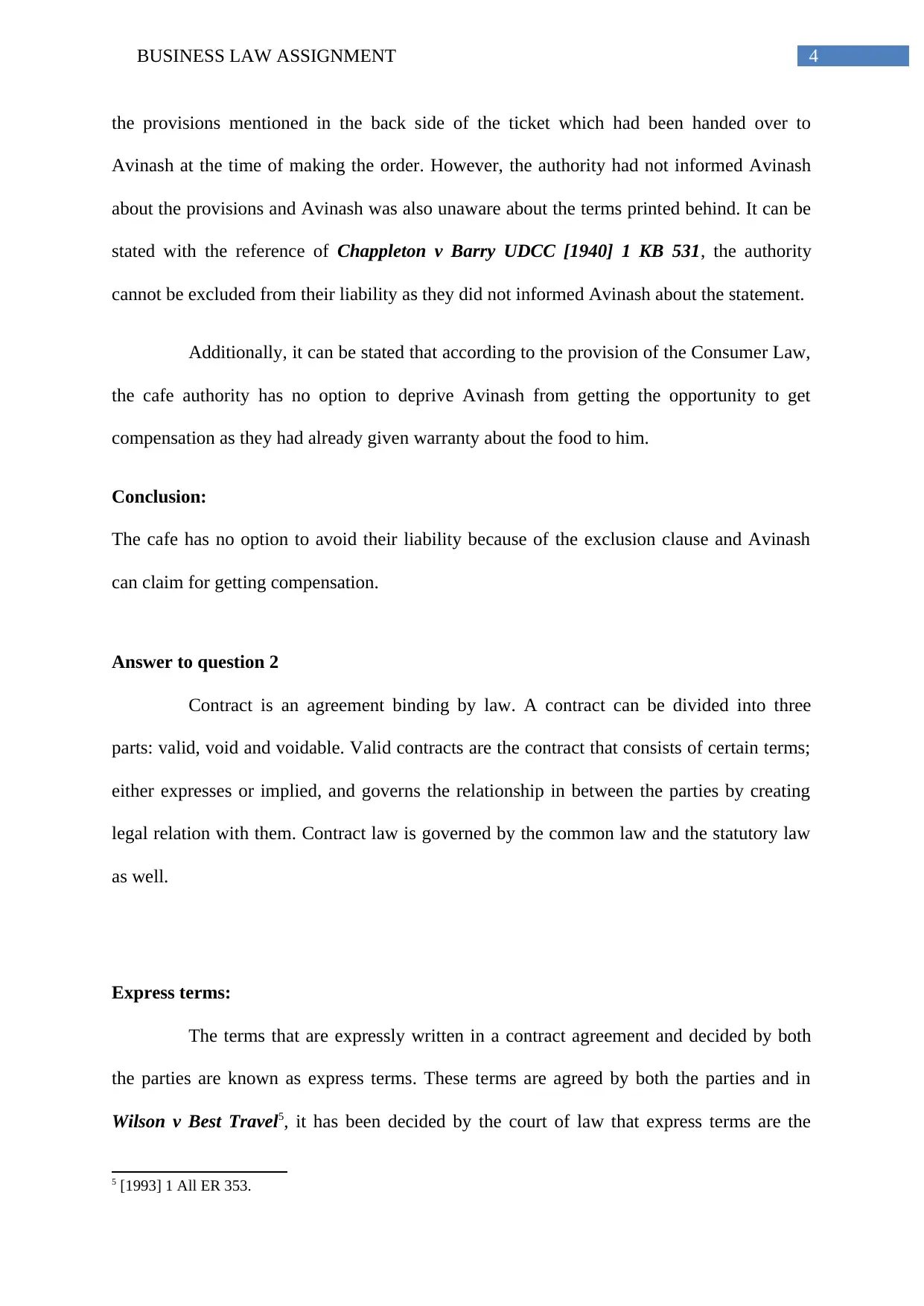
4BUSINESS LAW ASSIGNMENT
the provisions mentioned in the back side of the ticket which had been handed over to
Avinash at the time of making the order. However, the authority had not informed Avinash
about the provisions and Avinash was also unaware about the terms printed behind. It can be
stated with the reference of Chappleton v Barry UDCC [1940] 1 KB 531, the authority
cannot be excluded from their liability as they did not informed Avinash about the statement.
Additionally, it can be stated that according to the provision of the Consumer Law,
the cafe authority has no option to deprive Avinash from getting the opportunity to get
compensation as they had already given warranty about the food to him.
Conclusion:
The cafe has no option to avoid their liability because of the exclusion clause and Avinash
can claim for getting compensation.
Answer to question 2
Contract is an agreement binding by law. A contract can be divided into three
parts: valid, void and voidable. Valid contracts are the contract that consists of certain terms;
either expresses or implied, and governs the relationship in between the parties by creating
legal relation with them. Contract law is governed by the common law and the statutory law
as well.
Express terms:
The terms that are expressly written in a contract agreement and decided by both
the parties are known as express terms. These terms are agreed by both the parties and in
Wilson v Best Travel5, it has been decided by the court of law that express terms are the
5 [1993] 1 All ER 353.
the provisions mentioned in the back side of the ticket which had been handed over to
Avinash at the time of making the order. However, the authority had not informed Avinash
about the provisions and Avinash was also unaware about the terms printed behind. It can be
stated with the reference of Chappleton v Barry UDCC [1940] 1 KB 531, the authority
cannot be excluded from their liability as they did not informed Avinash about the statement.
Additionally, it can be stated that according to the provision of the Consumer Law,
the cafe authority has no option to deprive Avinash from getting the opportunity to get
compensation as they had already given warranty about the food to him.
Conclusion:
The cafe has no option to avoid their liability because of the exclusion clause and Avinash
can claim for getting compensation.
Answer to question 2
Contract is an agreement binding by law. A contract can be divided into three
parts: valid, void and voidable. Valid contracts are the contract that consists of certain terms;
either expresses or implied, and governs the relationship in between the parties by creating
legal relation with them. Contract law is governed by the common law and the statutory law
as well.
Express terms:
The terms that are expressly written in a contract agreement and decided by both
the parties are known as express terms. These terms are agreed by both the parties and in
Wilson v Best Travel5, it has been decided by the court of law that express terms are the
5 [1993] 1 All ER 353.
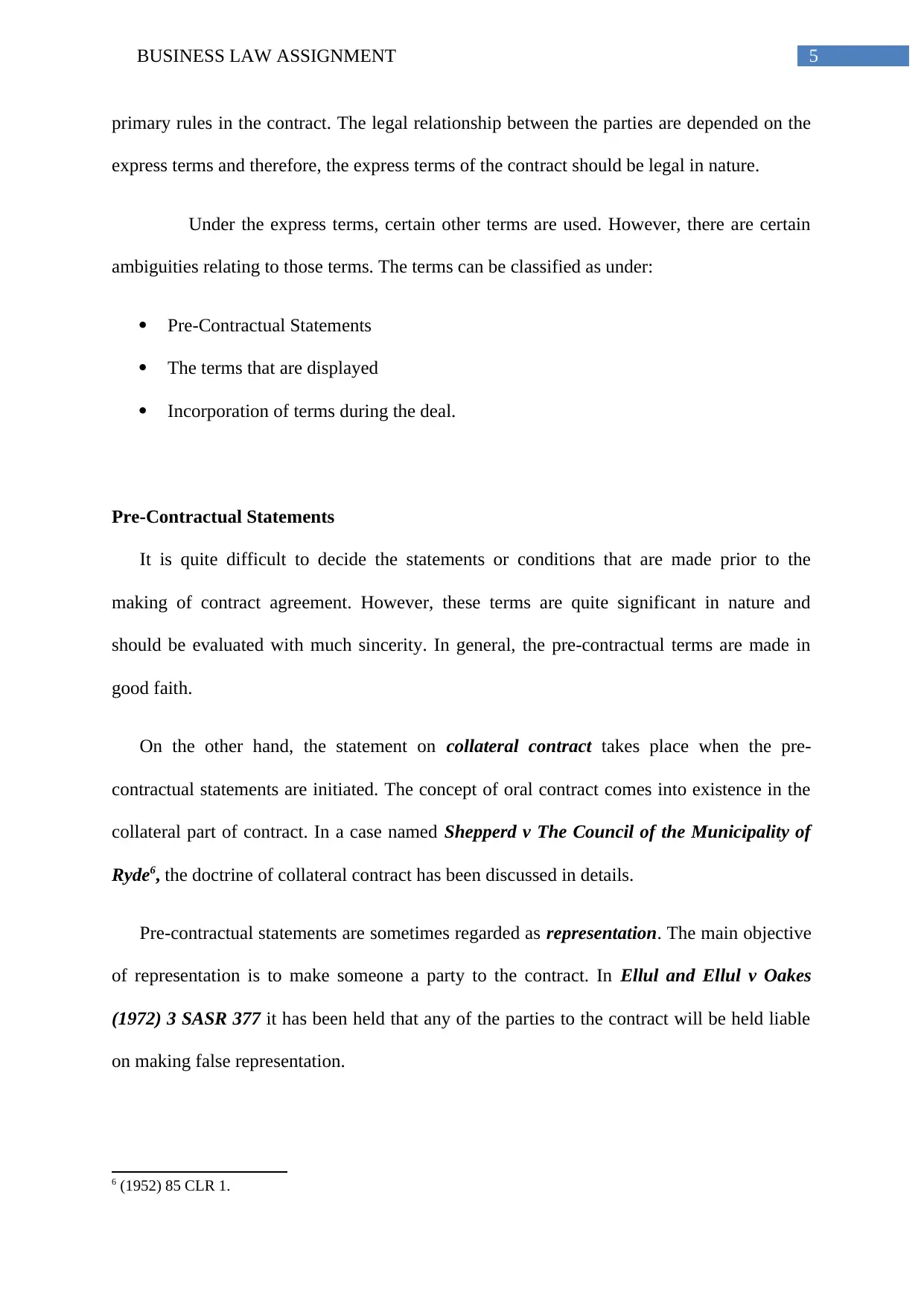
5BUSINESS LAW ASSIGNMENT
primary rules in the contract. The legal relationship between the parties are depended on the
express terms and therefore, the express terms of the contract should be legal in nature.
Under the express terms, certain other terms are used. However, there are certain
ambiguities relating to those terms. The terms can be classified as under:
Pre-Contractual Statements
The terms that are displayed
Incorporation of terms during the deal.
Pre-Contractual Statements
It is quite difficult to decide the statements or conditions that are made prior to the
making of contract agreement. However, these terms are quite significant in nature and
should be evaluated with much sincerity. In general, the pre-contractual terms are made in
good faith.
On the other hand, the statement on collateral contract takes place when the pre-
contractual statements are initiated. The concept of oral contract comes into existence in the
collateral part of contract. In a case named Shepperd v The Council of the Municipality of
Ryde6, the doctrine of collateral contract has been discussed in details.
Pre-contractual statements are sometimes regarded as representation. The main objective
of representation is to make someone a party to the contract. In Ellul and Ellul v Oakes
(1972) 3 SASR 377 it has been held that any of the parties to the contract will be held liable
on making false representation.
6 (1952) 85 CLR 1.
primary rules in the contract. The legal relationship between the parties are depended on the
express terms and therefore, the express terms of the contract should be legal in nature.
Under the express terms, certain other terms are used. However, there are certain
ambiguities relating to those terms. The terms can be classified as under:
Pre-Contractual Statements
The terms that are displayed
Incorporation of terms during the deal.
Pre-Contractual Statements
It is quite difficult to decide the statements or conditions that are made prior to the
making of contract agreement. However, these terms are quite significant in nature and
should be evaluated with much sincerity. In general, the pre-contractual terms are made in
good faith.
On the other hand, the statement on collateral contract takes place when the pre-
contractual statements are initiated. The concept of oral contract comes into existence in the
collateral part of contract. In a case named Shepperd v The Council of the Municipality of
Ryde6, the doctrine of collateral contract has been discussed in details.
Pre-contractual statements are sometimes regarded as representation. The main objective
of representation is to make someone a party to the contract. In Ellul and Ellul v Oakes
(1972) 3 SASR 377 it has been held that any of the parties to the contract will be held liable
on making false representation.
6 (1952) 85 CLR 1.
⊘ This is a preview!⊘
Do you want full access?
Subscribe today to unlock all pages.

Trusted by 1+ million students worldwide
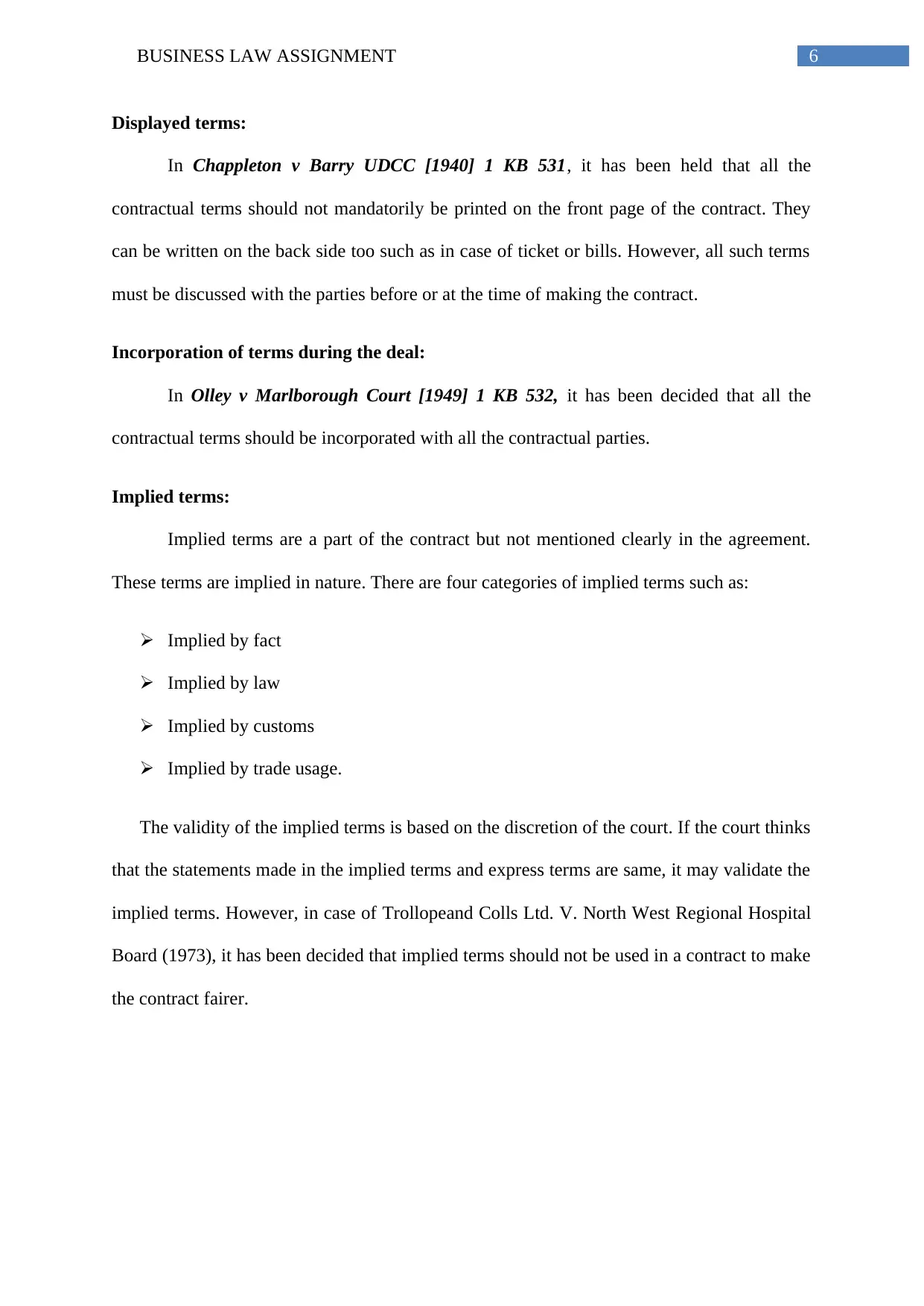
6BUSINESS LAW ASSIGNMENT
Displayed terms:
In Chappleton v Barry UDCC [1940] 1 KB 531, it has been held that all the
contractual terms should not mandatorily be printed on the front page of the contract. They
can be written on the back side too such as in case of ticket or bills. However, all such terms
must be discussed with the parties before or at the time of making the contract.
Incorporation of terms during the deal:
In Olley v Marlborough Court [1949] 1 KB 532, it has been decided that all the
contractual terms should be incorporated with all the contractual parties.
Implied terms:
Implied terms are a part of the contract but not mentioned clearly in the agreement.
These terms are implied in nature. There are four categories of implied terms such as:
Implied by fact
Implied by law
Implied by customs
Implied by trade usage.
The validity of the implied terms is based on the discretion of the court. If the court thinks
that the statements made in the implied terms and express terms are same, it may validate the
implied terms. However, in case of Trollopeand Colls Ltd. V. North West Regional Hospital
Board (1973), it has been decided that implied terms should not be used in a contract to make
the contract fairer.
Displayed terms:
In Chappleton v Barry UDCC [1940] 1 KB 531, it has been held that all the
contractual terms should not mandatorily be printed on the front page of the contract. They
can be written on the back side too such as in case of ticket or bills. However, all such terms
must be discussed with the parties before or at the time of making the contract.
Incorporation of terms during the deal:
In Olley v Marlborough Court [1949] 1 KB 532, it has been decided that all the
contractual terms should be incorporated with all the contractual parties.
Implied terms:
Implied terms are a part of the contract but not mentioned clearly in the agreement.
These terms are implied in nature. There are four categories of implied terms such as:
Implied by fact
Implied by law
Implied by customs
Implied by trade usage.
The validity of the implied terms is based on the discretion of the court. If the court thinks
that the statements made in the implied terms and express terms are same, it may validate the
implied terms. However, in case of Trollopeand Colls Ltd. V. North West Regional Hospital
Board (1973), it has been decided that implied terms should not be used in a contract to make
the contract fairer.
Paraphrase This Document
Need a fresh take? Get an instant paraphrase of this document with our AI Paraphraser
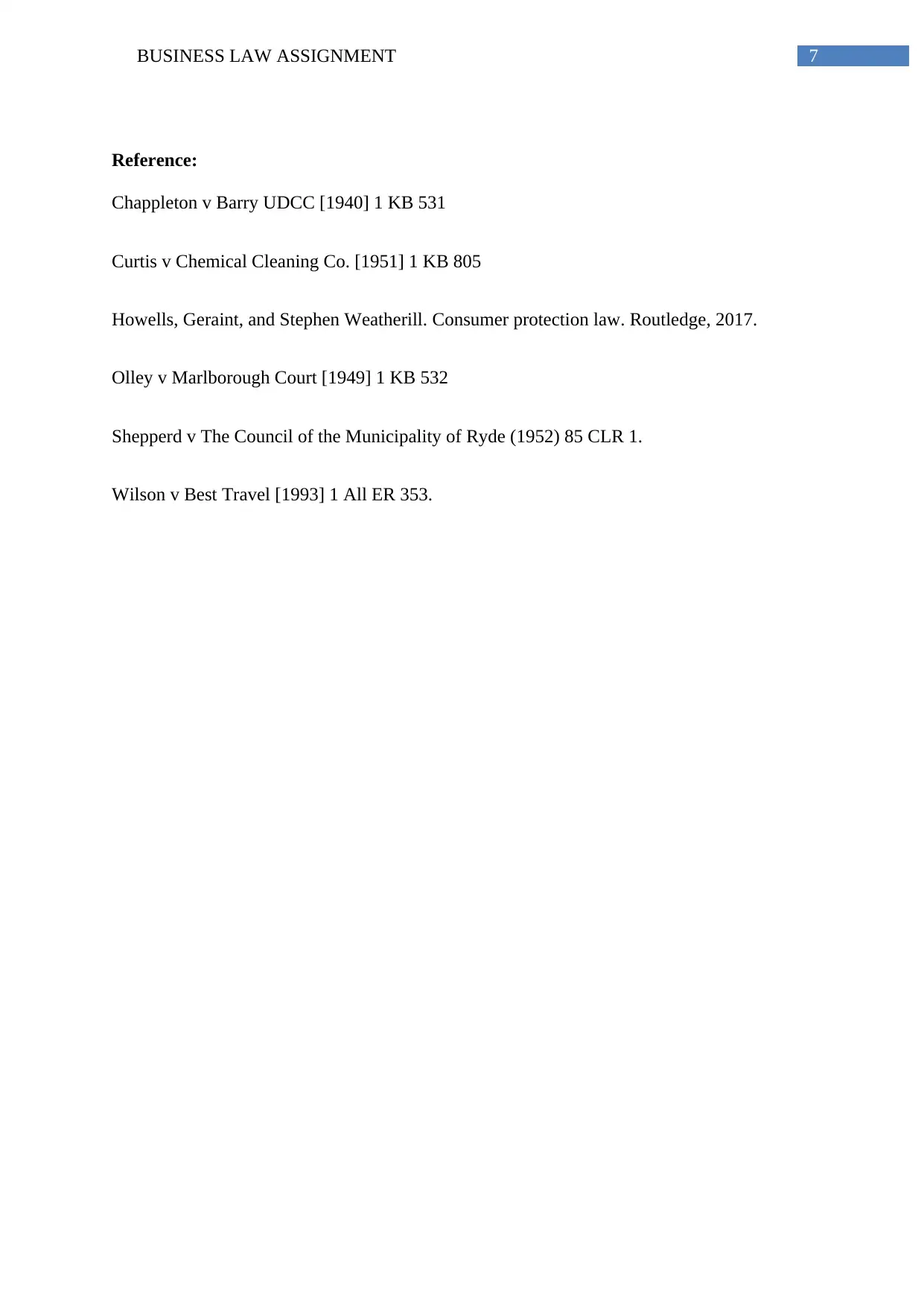
7BUSINESS LAW ASSIGNMENT
Reference:
Chappleton v Barry UDCC [1940] 1 KB 531
Curtis v Chemical Cleaning Co. [1951] 1 KB 805
Howells, Geraint, and Stephen Weatherill. Consumer protection law. Routledge, 2017.
Olley v Marlborough Court [1949] 1 KB 532
Shepperd v The Council of the Municipality of Ryde (1952) 85 CLR 1.
Wilson v Best Travel [1993] 1 All ER 353.
Reference:
Chappleton v Barry UDCC [1940] 1 KB 531
Curtis v Chemical Cleaning Co. [1951] 1 KB 805
Howells, Geraint, and Stephen Weatherill. Consumer protection law. Routledge, 2017.
Olley v Marlborough Court [1949] 1 KB 532
Shepperd v The Council of the Municipality of Ryde (1952) 85 CLR 1.
Wilson v Best Travel [1993] 1 All ER 353.
1 out of 8
Related Documents
Your All-in-One AI-Powered Toolkit for Academic Success.
+13062052269
info@desklib.com
Available 24*7 on WhatsApp / Email
![[object Object]](/_next/static/media/star-bottom.7253800d.svg)
Unlock your academic potential
Copyright © 2020–2025 A2Z Services. All Rights Reserved. Developed and managed by ZUCOL.





